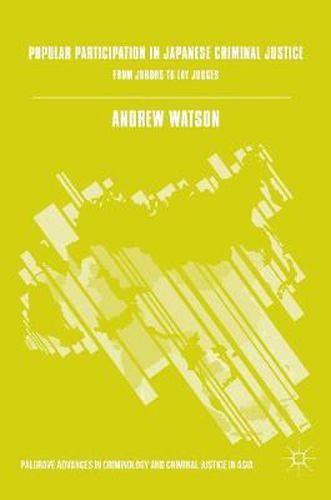Readings Newsletter
Become a Readings Member to make your shopping experience even easier.
Sign in or sign up for free!
You’re not far away from qualifying for FREE standard shipping within Australia
You’ve qualified for FREE standard shipping within Australia
The cart is loading…






This title is printed to order. This book may have been self-published. If so, we cannot guarantee the quality of the content. In the main most books will have gone through the editing process however some may not. We therefore suggest that you be aware of this before ordering this book. If in doubt check either the author or publisher’s details as we are unable to accept any returns unless they are faulty. Please contact us if you have any questions.
This book analyses the mixed courts of professional and lay judges in the Japanese criminal justice system. It takes a particular focus on the highly public start of the mixed court, the saiban-in system, and the jury system between 1928-1943. This was the first time Japanese citizens participated as decision makers in criminal law. The book assesses reasons for the jury system’s failure, and its suspension in 1943, as well as the renewed interest in popular involvement in criminal justice at the end of the twentieth century.
Popular Participation in Japanese Criminal Justice proceeds by explaining the process by which lay participation in criminal trials left the periphery to become an important national matter at the turn of the century. It shows that rather than an Anglo-American jury model, outline recommendations made by the Japanese Judicial Reform Council were for a mixed court of judges and laypersons to try serious cases. Concerns about the lay judge/saiban-in system are raised, as well as explanations for why it is flourishing in contemporary society despite the failure of the jury system during the period 1928-1943. The book presents the wider significance of Japanese mixed courts in Asia and beyond, and in doing so will be of great interests to scholars of socio-legal studies, criminology and criminal justice.
$9.00 standard shipping within Australia
FREE standard shipping within Australia for orders over $100.00
Express & International shipping calculated at checkout
This title is printed to order. This book may have been self-published. If so, we cannot guarantee the quality of the content. In the main most books will have gone through the editing process however some may not. We therefore suggest that you be aware of this before ordering this book. If in doubt check either the author or publisher’s details as we are unable to accept any returns unless they are faulty. Please contact us if you have any questions.
This book analyses the mixed courts of professional and lay judges in the Japanese criminal justice system. It takes a particular focus on the highly public start of the mixed court, the saiban-in system, and the jury system between 1928-1943. This was the first time Japanese citizens participated as decision makers in criminal law. The book assesses reasons for the jury system’s failure, and its suspension in 1943, as well as the renewed interest in popular involvement in criminal justice at the end of the twentieth century.
Popular Participation in Japanese Criminal Justice proceeds by explaining the process by which lay participation in criminal trials left the periphery to become an important national matter at the turn of the century. It shows that rather than an Anglo-American jury model, outline recommendations made by the Japanese Judicial Reform Council were for a mixed court of judges and laypersons to try serious cases. Concerns about the lay judge/saiban-in system are raised, as well as explanations for why it is flourishing in contemporary society despite the failure of the jury system during the period 1928-1943. The book presents the wider significance of Japanese mixed courts in Asia and beyond, and in doing so will be of great interests to scholars of socio-legal studies, criminology and criminal justice.